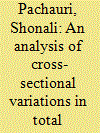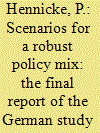|
|
|
Sort Order |
|
|
|
Items / Page
|
|
|
|
|
|
|
| Srl | Item |
| 1 |
ID:
052298


|
|
|
|
|
| Publication |
Oct 2004.
|
| Summary/Abstract |
Using micro level household survey data from India, we analyse the variation in the pattern and quantum of household energy requirements, both direct and indirect, and the factors causing such variation. An econometric analysis using household survey data from India for the year 1993–1994 reveals that household socio-economic, demographic, geographic, family and dwelling attributes influence the total household energy requirements. There are also large variations in the pattern of energy requirements across households belonging to different expenditure classes. Results from the econometric estimation show that total household expenditure or income level is the most important explanatory variable causing variation in energy requirements across households. In addition, the size of the household dwelling and the age of the head of the household are related to higher household energy requirements. In contrast, the number of members in the household and literacy of the head are associated with lower household energy requirements.
|
|
|
|
|
|
|
|
|
|
|
|
|
|
|
|
| 2 |
ID:
052297


|
|
|
|
|
| Publication |
Oct 2004.
|
| Summary/Abstract |
The use of biomass in Finland and Sweden has steadily increased over the past 25 years, up to approximately 20% of the primary energy supply in 2001. In both countries most biomass originates from forests. Forest biomass is now an integral part of modern energy systems, although primarily in industry and in the heating sector. For example, biomass accounts for 7.9% and 53% of the fuel mix in district heating in Finland and Sweden, respectively.
The general energy policy of both countries has supported biomass for energy over the entire period, although specific policies have changed with time. Research, development and demonstration has been continuously supported, and some subsidy schemes have been applied, in particular, for district heating systems (DHS) and combined heat and power. Heavy taxation of competing fossil fuels seems to have been the most effective policy instrument, although this has been directed mainly at the heat and transportation fuel markets. Electricity taxes are imposed on consumption (industry is largely exempt), and do not discriminate significantly between the sources of electricity. Starting in 2003, Sweden will have a quota-based system, a renewable portfolio standard, which is expected to increase biomass-based electricity production.
Both countries possess vast and not fully exploited biomass resources in the form of forests, and have a history of rational and large-scale forestry. Strong actors exist both with regard to forest ownership and the industrial processing of forest products. The user side, in particular, represented by DHS, can also be characterised by strong and professional management. Over time, structures have developed that facilitate an increased use of biomass for energy, for example, the forest industry infrastructure and extensive district heating. Actors within these structures have had the ability to react to policies, resulting in a stable growth in biomass use.
|
|
|
|
|
|
|
|
|
|
|
|
|
|
|
|
| 3 |
ID:
052294


|
|
|
|
|
| Publication |
Oct 2004.
|
| Summary/Abstract |
The purpose of this paper is to weigh the issues and options for increasing electricity access in remote and geographically challenged villages in interior Rajasthan, the desertstate in Western India where power sector reforms are currently underway. By first providing an overview of reforms and various electrification policy initiatives in India, the paper then analyzes the specific problems as studied at the grass-roots level with respect to rural electricity access and the use of off-grid renewables. Finally, it discusses interventions that could facilitate access to electricity by suggesting a sequential distributed generation (DG)-based approach, wherein consecutive DG schemes-incorporating the requisite technological, financial, and institutional arrangements-are designed depending on the developmental requirements of the community. In essence, this approach fits under the broader need to understand how the three "Rs"- rural electrification (the process), power sector reforms (the catalyst), and the use of renewable energy technologies (the means)-could potentially converge to meet the needs of India's rural poor.
|
|
|
|
|
|
|
|
|
|
|
|
|
|
|
|
| 4 |
ID:
052293


|
|
|
|
|
| Publication |
Oct 2004.
|
| Summary/Abstract |
This paper presents the results of using a stylized optimization model of the global electricity supply system to analyze the optimal research and development (R&D) support for an energy technology. The model takes into account the dynamics of technological progress as described by a so-called two-factor learning curve (2FLC). The two factors are cumulative experience ("learning by doing") and accumulated knowledge ("learning by searching"); the formulation is a straightforward expansion of conventional one-factor learning curves, in which only cumulative experience is included as a factor, which aggregates the effects of accumulated knowledge and cumulative experience, among others. The responsiveness of technological progress to the two factors is quantified using learning parameters, which are estimated using empirical data. Sensitivities of the model results to the parameters are also tested. The model results also address the effect of competition between technologies and of CO2 constraints. The results are mainly methodological; one of the most interesting is that, at least up to a point, competition between technologies-in terms of both market share and R&D support-need not lead to "lock-in" or "crowding-out".
|
|
|
|
|
|
|
|
|
|
|
|
|
|
|
|
| 5 |
ID:
052306


|
|
|
| 6 |
ID:
052299


|
|
|
|
|
| Publication |
Oct 2004.
|
| Summary/Abstract |
In this paper, the opportunity for the inter-regional integration of the electricity market in East China is analysed on the basis of strategies for the future expansion of the electricity generation system. We assume that during its first stage, the operational breakthrough of the electricity sector reform in China will be to achieve an economic dispatch of the generating plants. On the basis of this assumed goal a multi-region model is proposed to appraise the potential benefits of an integrated inter-regional electricity market. This model includes: propositions on design and operation of the market, electricity demand forecasting, least-cost generating system expansion. As case study, three strategies of electricity supply are assessed in two provinces: Shandong and Shanghai in East China. While Shandong is a potential electricity exporter due to availability of primary energy resources, Shanghai is an electricity importer. The strategies include: autarkical expansion of each regional system, import/export only for minimizing operation costs, integration of the system expansion for minimizing total costs including operation and investment costs. One of the findings is that building up an inter-regional integrated electricity market is profitable for both the Shanghai and Shandong regions compared with the two other strategies, if the future regulation makes it possible to insure an economic dispatch of the generating power plants.
|
|
|
|
|
|
|
|
|
|
|
|
|
|
|
|
| 7 |
ID:
052292


|
|
|
|
|
| Publication |
Oct 2004.
|
| Summary/Abstract |
In February 2000, the German Bundestag established a Study Commission on "Sustainable Energy Supplies in View of Globalisation and Liberalisation" (cf. Final Report, 2002). The Commission's Final Report is a contribution made by Germany toward implementing the sustainable development objectives defined in 1992 at the World Summit in Rio de Janeiro (Agenda 21). Despite minority votes of several members of the Study Commission, the main outcomes of the Final Report are worthwhile discussing in other industrial countries. The Commission had been given the mandate to identify "robust, sustainable development paths" for the energy sector for the period up to 2050, which represent a scientific basis for the German parliament's further decision-making in the field of long-term energy policy. The applied backcasting approach showed that an ambitious climate-protection goal-reducing CO2 emissions by 80% by 2050-is technically and economically feasible. The main strategies and instruments for protecting the climate while ensuring a sustainable energy supply are summarised.
|
|
|
|
|
|
|
|
|
|
|
|
|
|
|
|
| 8 |
ID:
052300


|
|
|
|
|
| Publication |
Oct 2004.
|
| Summary/Abstract |
This article provides an econometric meta-analysis of the disparity of results among a large sample of electricity externality studies. Most importantly, the analysis shows that parts of the disparity can be attributed to methodological differences; the abatement cost and top-down damage cost approaches tend to produce higher external cost estimates, ceteris paribus, than does the bottom-up damage cost approach. There are also systematical differences in magnitudes among fuels; as expected some of the fuels (i.e., coal and oil) have more adverse impacts than do the renewables (i.e., hydro, wind and solar). Furthermore, the studies that have addressed the full fuel cycle tend to produce higher externality estimates. However, the analysis carried out here is not sufficient to explain all of the variability in externality estimates. Thus, overall the results suggest that the possibility of making general policy decisions based on the studies carried out so far may be limited, implying that existing externality studies may have to be improved in order to become more useful for policy makers.
|
|
|
|
|
|
|
|
|
|
|
|
|
|
|
|
|
|
|
|
|